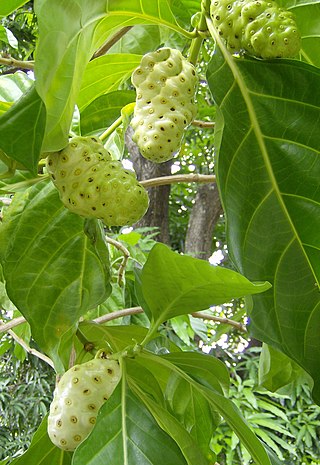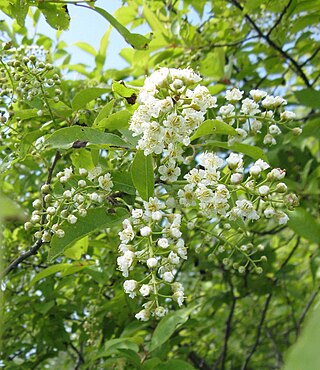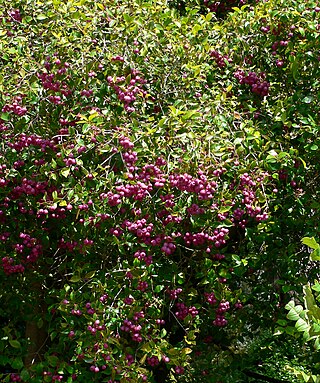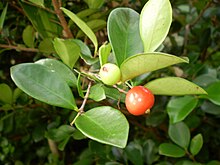
A cherry is the fruit of many plants of the genus Prunus, and is a fleshy drupe.

The persimmon is the edible fruit of a number of species of trees in the genus Diospyros. The most widely cultivated of these is the kaki persimmon, Diospyros kaki – Diospyros is in the family Ebenaceae, and a number of non-persimmon species of the genus are grown for ebony timber. In 2019, China produced 75% of the world total of persimmons.

Prunus laurocerasus, also known as cherry laurel, common laurel and sometimes English laurel in North America, is an evergreen species of cherry (Prunus), native to regions bordering the Black Sea in southwestern Asia and southeastern Europe, from Albania and Bulgaria east through Turkey to the Caucasus Mountains and northern Iran.

Morinda citrifolia is a fruit-bearing tree in the coffee family, Rubiaceae, native to Southeast Asia and Australasia, and was spread across the Pacific by Polynesian sailors. The species is now cultivated throughout the tropics and widely naturalized. There are over 100 names for this fruit across different regions. Common English names include great morinda, Indian mulberry, noni, beach mulberry, vomit fruit, awl tree, and cheese fruit.

Prunus virginiana, commonly called bitter-berry, chokecherry, Virginia bird cherry, and western chokecherry, is a species of bird cherry native to North America.

Eugenia is a genus of flowering plants in the myrtle family Myrtaceae. It has a worldwide, although highly uneven, distribution in tropical and subtropical regions. The bulk of the approximately 1,100 species occur in the New World tropics, especially in the northern Andes, the Caribbean, and the Atlantic Forest of eastern Brazil. Other centers of diversity include New Caledonia and Madagascar. Many of the species that occur in the Old World have received a new classification into the genus Syzygium.

Terminalia catappa is a large tropical tree in the leadwood tree family, Combretaceae, native to Asia, Australia, the Pacific, Madagascar and Seychelles. Common names in English include country almond, Indian almond, Malabar almond, sea almond, tropical almond, beach almond and false kamani.

Eugenia uniflora, the pitanga, Suriname cherry, Brazilian cherry, Cayenne cherry, cerisier carré, monkimonki kersie,ñangapirí, or shimarucu is a flowering plant in the family Myrtaceae, native to tropical South America’s east coast, ranging from Suriname, French Guiana to southern Brazil, as well as Uruguay and parts of Paraguay and Argentina. It is often used in gardens as a hedge or screen. The tree was introduced to Bermuda for ornamental purposes but is now out of control and listed as an invasive species. The tree has also been introduced to Florida.

Pandanus tectorius is a species of Pandanus (screwpine) that is native to Malesia, Papuasia, eastern Australia, and the Pacific Islands. It grows in the coastal lowlands typically near the edge of the ocean. Common names in English include thatch screwpine, Tahitian screwpine, hala tree and pandanus. The fruit is edible and sometimes known as hala fruit.

Syzygium smithii is a summer-flowering, winter-fruiting evergreen tree, native to Australia and belonging to the myrtle family Myrtaceae. It shares the common name "lilly pilly" with several other plants.It is planted as shrubs or hedgerows, and features: rough, woody bark; cream and green smooth, waxy leaves; flushes of pink new growth; and white to maroon edible berries. Unpruned, it will grow about 3–5 m (9.8–16.4 ft) tall in the garden.

Psidium cattleyanum , commonly known as Cattley guava, strawberry guava or cherry guava, is a small tree in the Myrtaceae (myrtle) family. The species is named in honour of English horticulturist William Cattley. Its genus name Psidium comes from the Latin psidion, or "armlet." The red-fruited variety, P. cattleyanum var. cattleyanum, is commonly known as purple guava, red cattley guava, red strawberry guava and red cherry guava. The yellow-fruited variety, P. cattleyanum var. littorale is variously known as yellow cattley guava, yellow strawberry guava, yellow cherry guava, lemon guava and in Hawaii as waiawī. Although P. cattleyanum has select economic uses, it is considered the most invasive plant in Hawaii.

Syzygium paniculatum, the magenta lilly pilly or magenta cherry, is a species of flowering plant in the myrtle family Myrtaceae, native to New South Wales, Australia. A broad dense bushy rainforest tree, in cultivation it grows to a height of 15 m (49 ft) with a trunk diameter up to 35 cm (14 in). The largest known example is at Ourimbah Creek, 35 m (115 ft) metres tall. The leaves are 3–9 cm (1.2–3.5 in) long, opposite, simple and slightly obovate, tapering at the leaf base. They are dark glossy green above, and paler below. White flowers are produced in clusters. The edible fruit is usually magenta, but can be white, pink or purple. The seeds are polyembryonic.

Syzygium malaccense is a species of flowering tree native to tropical Asia and Australia. It is one of the species cultivated since prehistoric times by the Austronesian peoples. They were carried and introduced deliberately to Remote Oceania as canoe plants. In modern times, it has been introduced throughout the tropics, including many Caribbean countries and territories.

Eugenia koolauensis, commonly known as Koʻolau eugenia or nioi, is a species of flowering plant in the myrtle family, Myrtaceae. It is endemic to Hawaii, where it could previously be found on the islands of Molokaʻi and Oʻahu; today populations only exist on the latter. This is a federally listed endangered species of the United States.

Antidesma bunius is a species of fruit tree in the family Phyllanthaceae. It is native to Southeast Asia and northern Australia. Its common Philippine name and other names include bignay, bugnay or bignai, Chinese-laurel, Queensland-cherry, salamander-tree, wild cherry, and currant tree.

Syzygium australe, with many common names that include brush cherry, scrub cherry, creek lilly-pilly, creek satinash, and watergum, is a rainforest tree native to eastern Australia. It can attain a height of up to 35 m with a trunk diameter of 60 cm. In cultivation, this species is usually a small to medium-sized tree with a maximum height of only 18m.

Prunus tomentosa is a species of Prunus native to northern and western China, Korea, Mongolia, and possibly northern India. Common names for Prunus tomentosa include Nanjing cherry, Korean cherry, Manchu cherry, downy cherry, Shanghai cherry, Ando cherry, mountain cherry, Chinese bush cherry, and Chinese dwarf cherry.

Santalum freycinetianum, the forest sandalwood, Freycinet sandalwood, or ʻIliahi, is a species of flowering tree in the European mistletoe family, Santalaceae, that is endemic to the Hawaiian Islands. Its binomial name commemorates Henri Louis Claude de Saulces de Freycinet, a 19th-century French explorer. ʻIliahi inhabits dry, coastal mesic, mixed mesic, and wet forests on Oʻahu, Kauaʻi, Lānaʻi, Maui, and Molokaʻi at elevations of 250–950 m (820–3,120 ft). It grows in areas that receive 500–3,800 mm (20–150 in) of annual rainfall. Like other members of its genus, ʻiliahi is a root hemi-parasite, deriving some of its nutrients from the host plant; common hosts include koa, koaiʻa, and ʻaʻaliʻi.

Santalum ellipticum, commonly known as ʻIliahialoʻe (Hawaiian) or coastal sandalwood, is a species of flowering plant in the mistletoe family, Santalaceae, that is endemic to the Hawaiian Islands. It is a sprawling shrub to small tree, typically reaching a height of 1–5 m (3.3–16.4 ft) and a canopy spread of 1–3 m (3.3–9.8 ft), but is extremely variable in size and shape. Like other members of the genus, S. ellipticum is a hemi-parasite, deriving some of its nutrients from the host plant by attaching to its roots.

Exocarpos latifolius is a species of parasitic tree, in the plant family Santalaceae. They have the common names broad leaved ballart, scrub sandal-wood, scrub cherry, oringorin, broad leaved cherry or native cherry. The species is found in monsoon forest, littoral rainforest and occasionally in more open forest types in Malesia and across Northern Australia.




















